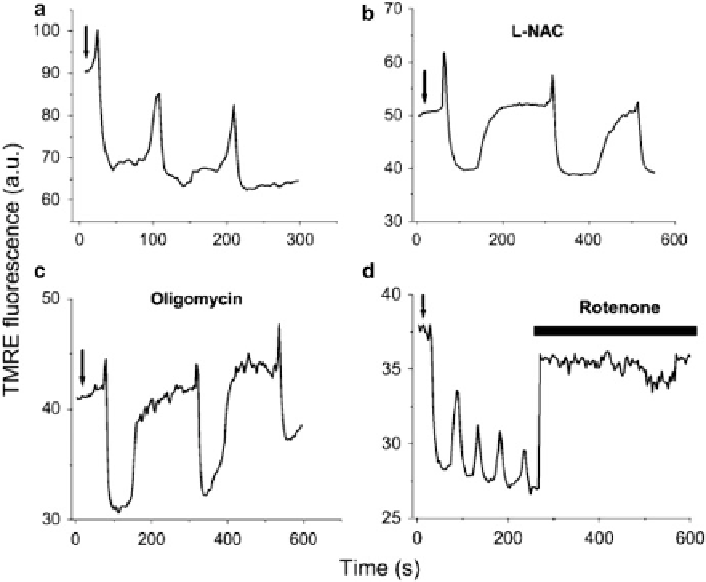Biology Reference
In-Depth Information
Fig. 5.6 Effects of scavengers or inhibitors of ROS production on mitochondrial oscillations.
Recordings of the TMRE signal of myocytes showing cell-wide mitochondrial oscillations after a
laser flash (
arrows
) in the absence (a) or in the presence of 4 mM
N
-acetyl-L-cysteine (L-NAC) for
30 min (b), or 10
μ
g/ml of oligomycin for 60 min (c), or after the acute addition of rotenone
(15
M) (d). Oscillations in mitochondrial metabolism were triggered as described in Fig.
5.4
(see
also text). Reproduced from Cortassa, Aon, Winslow, O'Rourke (2004) Biophys J 87, 2060-73
μ
5.3 First Iterative Loop: Cell-wide Mitochondrial
Oscillations
Cell-wide synchronized oscillations in mitochondrial NADH,
ΔΨ
m
, and ROS
could be reproducibly triggered by a focalized laser flash affecting only a few
mitochondria (Fig.
5.4
). We used two-photon scanning laser fluorescence micro-
scopy and a laser flash to induce localized oxidative stress in a few mitochondria
(~50). After a few seconds (~40 s on average), a synchronized cell-wide
ΔΨ
m
depolarization occurred that extended and prolonged into cell-wide oscillations of
the mitochondrial network in all tested energetic/redox variables (
ΔΨ
m
, NADH,
ROS, GSH) (Figs.
5.4
,
5.5
, and
5.7
).
We then concentrated on the cellular redox balance affecting the ROS produc-
tion and ROS scavenging capacity of cells (Fig.
5.6
). The oscillations could be
slowed by increasing the ROS scavenging capacity of the cell (Fig.
5.6b
), or by

Search WWH ::

Custom Search